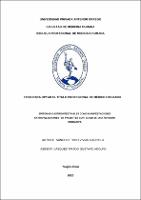Mostrar el registro sencillo del ítem
Síntomas gastrointestinales como manifestaciones extrapulmonares en pacientes con COVID-19. Una revisión narrativa
| dc.contributor.advisor | Vásquez Tirado, Gustavo Adolfo | |
| dc.contributor.author | Sánchez Toro, Vivian Gabriela | |
| dc.creator | Sánchez Toro, Vivian Gabriela | |
| dc.date.accessioned | 2020-12-29T01:33:29Z | |
| dc.date.available | 2020-12-29T01:33:29Z | |
| dc.date.issued | 2020 | |
| dc.identifier.uri | https://hdl.handle.net/20.500.12759/7003 | |
| dc.description.abstract | La pandemia por COVID-19 está marcando un hito en la historia de la medicina y de la humanidad. La infección por SARS-CoV-2 afecta principalmente el sistema respiratorio generando desde enfermedad leve hasta cuadros severos; sin embargo, también se han observado múltiples manifestaciones extrapulmonares en diversos sistemas y órganos. Las células epiteliales del tubo digestivo y árbol hepatobiliar expresan ECA2 y TMPRSS2 necesarios para el ingreso viral, por otro lado, el ARN viral ha sido detectado en muestras de heces, incluso después de haberse negativizado en muestras respiratorias. La presencia de manifestaciones clínicas digestivas se asocia a mayor carga viral y en ocasiones pueden ser las únicas manifestaciones de COVID-19, incluso en ausencia de síntomas respiratorios. Los síntomas más comunes son anorexia (39,9% – 50.2%) y diarrea (2% – 49,5%); seguidos por las náuseas (1% - 29,4%), vómitos (3,6% - 66,7%) y dolor abdominal (2,2% – 6%), siendo este último característico de pacientes gravemente enfermos. Es muy poco frecuente la presencia de hemorragia gastrointestinal, colitis hemorrágica o hepatitis aguda. Un hallazgo característico en pacientes con COVID-19 son la elevación de las transaminasas, aunque estos valores usualmente no son mayores a 5 veces el límite superior normal, adicionalmente la hiperbilirrubinemia puede ser un hallazgo frecuente. Ante un paciente con manifestaciones gastrointestinales debe considerarse a COVID-19 dentro del diagnóstico diferencial y tomarse todas las medidas de prevención necesarias, ante el potencial riesgo de infección. | es_PE |
| dc.description.abstract | The COVID-19 pandemic is marking a milestone in the history of medicine and humanity. The SARS-CoV-2 infection mainly affects the respiratory system, generating from mild to severe disease; however, multiple extrapulmonary manifestations have also been observed in various systems and organs. Epithelial cells of digestive and hepatobiliary tract express ECA2 and TMPRSS2 necessary for viral entry, on the other hand, viral RNA has been detected in stool samples, even after being negativized in respiratory samples. The presence of clinical digestive manifestations is associated to a higher viral load and sometimes they can be the only manifestations of COVID-19, even in the absence of respiratory symptoms. The most common symptoms are anorexia (39.9% - 50.2%) and diarrhea (2% - 49.5%); followed by nausea (1% - 29.4%), vomiting (3.6% - 66.7%) and abdominal pain (2.2% - 6%), the latter being characteristic of seriously ill patients. The presence of gastrointestinal bleeding, hemorrhagic colitis or acute hepatitis is very rare. A characteristic finding in patients with COVID-19 is the elevation of transaminases, although these values usually are not greater than 5 times the upper normal limit, additionally hyperbilirubinemia can be a frequent finding. In case of a patient with gastrointestinal manifestations, COVID-19 must be considered within the differential diagnosis and all the necessary prevention measures must be taken, due to the potential risk of infection. | en_US |
| dc.description.uri | Tesis | es_PE |
| dc.format | application/pdf | es_PE |
| dc.language.iso | spa | es_PE |
| dc.publisher | Universidad Privada Antenor Orrego | es_PE |
| dc.relation.ispartofseries | T_MED_2922 | |
| dc.rights | info:eu-repo/semantics/openAccess | es_PE |
| dc.rights.uri | https://creativecommons.org/licenses/by/4.0/ | es_PE |
| dc.source | Universidad Privada Antenor Orrego | es_PE |
| dc.source | Repositorio Institucional - UPAO | es_PE |
| dc.subject | COVID-19 | es_PE |
| dc.subject | Sistema digestivo | es_PE |
| dc.subject | Síntomas digestivos | es_PE |
| dc.title | Síntomas gastrointestinales como manifestaciones extrapulmonares en pacientes con COVID-19. Una revisión narrativa | es_PE |
| dc.type | info:eu-repo/semantics/bachelorThesis | es_PE |
| thesis.degree.level | Título Profesional | es_PE |
| thesis.degree.grantor | Universidad Privada Antenor Orrego. Facultad de Medicina Humana | es_PE |
| thesis.degree.name | Médico Cirujano | es_PE |
| thesis.degree.discipline | Medicina Humana | es_PE |
| dc.subject.ocde | https://purl.org/pe-repo/ocde/ford#3.02.27 | es_PE |
| renati.author.dni | 71000683 | |
| renati.type | https://purl.org/pe-repo/renati/type#tesis | es_PE |
| renati.level | https://purl.org/pe-repo/renati/level#tituloProfesional | es_PE |
| renati.discipline | 912016 | es_PE |
| dc.publisher.country | PE | es_PE |
Ficheros en el ítem
Este ítem aparece en la(s) siguiente(s) colección(es)
-
Medicina Humana [3015]


